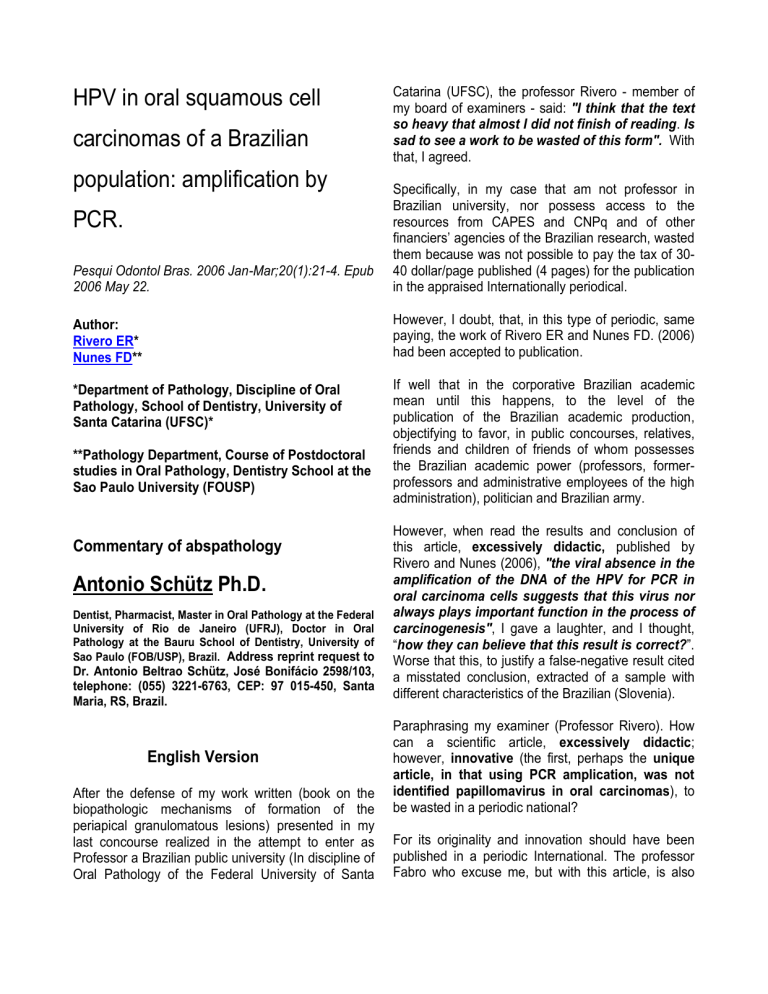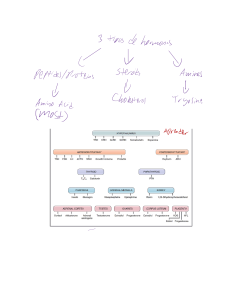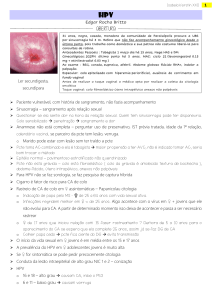HPV in oral squamous cell carcinomas of a

HPV in oral squamous cell carcinomas of a Brazilian population: amplification by
PCR.
Pesqui Odontol Bras. 2006 Jan-Mar;20(1):21-4. Epub
2006 May 22.
Author:
Rivero ER *
Nunes FD **
*Department of Pathology, Discipline of Oral
Pathology, School of Dentistry, University of
Santa Catarina (UFSC)*
**Pathology Department, Course of Postdoctoral studies in Oral Pathology, Dentistry School at the
Sao Paulo University (FOUSP)
Commentary of abspathology
Antonio Schütz Ph.D.
Dentist, Pharmacist, Master in Oral Pathology at the Federal
University of Rio de Janeiro (UFRJ), Doctor in Oral
Pathology at the Bauru School of Dentistry, University of
Sao Paulo (FOB/USP), Brazil. Address reprint request to
Dr. Antonio Beltrao Schütz, José Bonifácio 2598/103, telephone: (055) 3221-6763, CEP: 97 015-450, Santa
Maria, RS, Brazil.
English Version
After the defense of my work written (book on the biopathologic mechanisms of formation of the periapical granulomatous lesions) presented in my last concourse realized in the attempt to enter as
Professor a Brazilian public university (In discipline of
Oral Pathology of the Federal University of Santa
Catarina (UFSC), the professor Rivero - member of my board of examiners - said: "I think that the text
so heavy that almost I did not finish of reading. Is
sad to see a work to be wasted of this form". With that, I agreed.
Specifically, in my case that am not professor in
Brazilian university, nor possess access to the resources from CAPES and CNPq and of other financiers’ agencies of the Brazilian research, wasted them because was not possible to pay the tax of 30-
40 dollar/page published (4 pages) for the publication in the appraised Internationally periodical.
However, I doubt, that, in this type of periodic, same paying, the work of Rivero ER and Nunes FD. (2006) had been accepted to publication.
If well that in the corporative Brazilian academic mean until this happens, to the level of the publication of the Brazilian academic production, objectifying to favor, in public concourses, relatives, friends and children of friends of whom possesses the Brazilian academic power (professors, formerprofessors and administrative employees of the high administration), politician and Brazilian army.
However, when read the results and conclusion of this article, excessively didactic, published by
Rivero and Nunes (2006), "the viral absence in the amplification of the DNA of the HPV for PCR in oral carcinoma cells suggests that this virus nor always plays important function in the process of
carcinogenesis", I gave a laughter, and I thought,
“how they can believe that this result is correct?”.
Worse that this, to justify a false-negative result cited a misstated conclusion, extracted of a sample with different characteristics of the Brazilian (Slovenia).
Paraphrasing my examiner (Professor Rivero). How can a scientific article, excessively didactic; however, innovative (the first, perhaps the unique article, in that using PCR amplication, was not
identified papillomavirus in oral carcinomas), to be wasted in a periodic national?
For its originality and innovation should have been published in a periodic International. The professor
Fabro who excuse me, but with this article, is also
necessary to be repetitive; particularly, with other method of extraction of DNA, or with another sample, excluding the excisional biopsies and/or the patients submitted to the treatment not exclusively surgical, such as with fluoracil and/or mitomicin associate to the treatment with radiation. Moreover, was not informed if the patient carriers of oral carcinoma HIV+ were enclosed or not with the study of Rivero ER and
Nunes FD. (20006.) considering that the medicaments used in the treatment of these patients, might have intervened in the viral load of papilloma virus.
I do not know if work "is weighed" for the reader not much erudite, or if the article of Rivero ER and Nunes
FD.(20006.) is excessively didactic because I had difficulty to understand the employed methodology, " only samples with visible APC were enclosed in
the study".
I did not understand if the authors started with a sample with more than 40 cases, having discarded the samples with PCR inhibitors; or if among the 40 studied cases, were discarded that with inhibitors of
PCR, submitting to the PCR DNA amplification, only with visible APC. In both alternatives, might have been discarded positive samples for HPV of low load viral and accented PCR inhibitor presence; partially, explaining the false-negative result.
Well! Lets’ go to stop with the preliminary and to leave for the finally (Now believe in me! I did not lie: during the defense - I consider the preliminaries as the part most important of a lesson). At the moment in that I displayed this idea perceived that a redness was transparent in the physiognomies of the teachers, indicative of that or they are working little or they are having problems in the preliminaries.
The results of the study of Rivero and Nunes (2006) contrast with the results published in the world-wide literature, since was reported for all the types of HPV a prevalence from 12.9 % to 30.3%, in squamous cells carcinomas. In relation to the 16 HPV from 7.7% to 25.2%; when is compared all the searched types of papilomavírus (6, 11, 16, 18, 31 and 33), the results also contrast because the literature reports the percentages of 3.1, 1.6, 16, 8, 0.2 and 0.8%. In addition, other types of papillomavírus have been identified in oral carcinomas (16 and 18, 32, 35, 44,
53, 56, 57, 58, 68 and 81.[1]
Contrasts also in relation to sensitivity of the techniques of sampling because was not identified difference between the study in biopsies and for scraping, considering that literature points this latter as the most accurate.
Considering still the accented relation between the
HPV, the use of the tobacco and the alcohol, as well as the high frequency of the use of tobacco and alcohol between Brazilian patients with oral cancer, this result also is contrasting. I particularly believe that occurs something similar to the cervical cancer, where is identified the synergic effect between papilloma virus and tobacco and alcohol, in relation to oral cancer.
Also in epithelial dysplasias of high degree, using itself immunehistochemistry and PCR amplification
6/41 (14.6%) lesions presented themselves posit for
HPV,[9] confirming the participation of the papillomavírus in the etiopathogenesis of the oral carcinoma, considering that besides influencing the potential of proliferation of the transformed neoplasic cells, it also increases the migration of these cells, for intervening with their adhesion to fibronectin of the extracellular matrix; as well as directly to induce phenotypes alterations related with the progression of the neoplasic cells in the cellular cycle.[10]
Besides, 28/40 (70%) oral carcinomas contained
HPV of type 16 and 18, and 11/15 (73%) oral carcinomas presented mutation in the gene p53 were
HPV positive.[13] Of the three works cited for the authors to justify the false-negative result of their work, in all was identified to viral presence (7,5, 2,6,
11%) [6, 7, 8].
Kansky et al. (2003)[6] - cited for the authors - identified the presence of papillomavírus of the types
16, 33 and 58 (8.4%) and of the types 11, 16, 31 and
68 (6.6%), whose resulted are also compatible with the literature.
In recent study, Kansky et al. (2006) reported the difference of 2.4% in relation to the presence of HPV in lesions of oral carcinoma, comparatively to the
control (normal oral mucous). In 4/44 (10%) lesions were identified the presence of HPV of types 6 and
16.11]
In Sweden, was identified a relation statistically significant between a high risk of infection for HPV and the oral carcinoma (63%); being the types of papilomavírus (HPV) of accented risk for the oral carcinoma, identical to the observed in the cervical cancer. [12] In Brazil, 20% of the leukoplastic lesions with accented degree of epithelial dysplasia are infected for papilomavírus of type 16/18; indicative of the participation of the HPV in the etiopathogesis of oral carcinoma. [15]
Such results, confirm the rarity of the result presented for professors Rivero and Nunes (2006), perhaps, the unique article reported in the world-wide literature where was not identified - using samples of amplified DNA PCR - the presence of
papilomavírus, in oral carcinomas.
Considering these results, possibly, false-negative, another method of extraction of DNA would be advisable to remake the experiment [3] because as alert D'Souza et al. (2006) [2] the method of purification and extraction of DNA has potential impact in the detection of the genomic DNA of the
HPV, in amplified samples PCR because of the presence of PCR inhibitors, in false-negative samples, particularly of the oral mucosa. The
References substitution of the purification method with proteinase
K + etanol for the method of lysis cellular with
"puregene" would produce better resulted (7-10%).
Another potential source of error may have been the acetate ammonium concentration used. Thus, we suggest the substitution for the methods of Miller et al. (1999) [4] or of Burger et al. (1996),[5] in samples gotten exclusively for scraping.
Another erroneous conclusion was to consider the decreased viral load, in oral carcinomas, caused by medicaments, as absence of infection for HPV. In the dependence of the viral load and of the concentration of PCR inhibitors, in each sample extract, the use of positive control does not exclude the possibility of false-negative result.
As the authors did not mention if the specimens were proceeding from incisional or excisional biopsies, or both. Nor if the 17 patients taken care in the Hospital of the Clinics at University of Sao Paulo (USP) were or were being submitted to medicament to treat cancer, is not improbable that a percentage relatively raised of false-negative results have occurred; particularly, because other studies carried through in
Latin America (population with similar characteristics), using similar methodology to used in the study of Rivero ER, Nunes FD (2006), aimed the percentage of 50% of oral carcinomas infected by
HPV. [14]
[1] Kreimer AR, Clifford GM, Boyle P, Franceschi S.
Human papillomavirus types in head and neck squamous cell carcinomas worldwide: a systematic review. Cancer Epidemiol
Biomarkers Prev. 2005 Feb;14(2):467-75.
Review.
[2] D'Souza G, Sugar E, Ruby W, Gravitt P, Gillison
M.
Analysis of the effect of DNA purification on detection of human papillomavirus in oral rinse samples by PCR. J Clin Microbiol. 2005
Nov;43(11):5526-35.
[3] Neves AC, Rivero ERC, Silva-Valenzuela MG,
Sousa SCOM, Nunes FD Método de extração de DNA de material de arquivo pelo acetato de amônio e pelo isopropanol
[resumo Pb329]. Pesqui Odontol Bras
2002;16:210.
[4] Miller DN, Bryant JE, Madsen EL, Ghiorse WC.
Evaluation and optimization of DNA extraction and purification procedures for soil and sediment samples. Appl Environ
Microbiol. 1999 Nov;65(11):4715-24.
[5] Burger RA, Monk BJ, Kurosaki T, Anton-Culver H,
Vasilev SA, Berman ML, Wilczynski
SP.
Human papillomavirus type 18: association with poor prognosis in early
stage cervical cancer.J Natl Cancer Inst.
1996 Oct 2;88(19):1361-8. Review
[6] Kansky AA, Poljak M, Seme K, Kocjan BJ, Gale
N, Luzar B, et al. Human papillomavirus DNA in oral squamous cell carcinomas and normal oral mucosa. Acta Virol 2003;47(1):11-6.
[7] Matzow T, Boysen M, Kalantari M, Johansson B,
Hagmar B. Low detection rate of HPV in oral and laryngeal carcinomas. Acta Oncol
1998;37(1):73-6.
[11] Kansky AA, Seme K, Maver PJ, Luzar B, Gale N,
Poljak M.
Human papillomaviruses (HPV) in tissue specimens of oral squamous cell papillomas and normal oral mucosa.
Anticancer Res. 2006 Jul-Aug;26(4B):3197-
201.
[12] Rosenquist K.
Risk factors in oral and oropharyngeal squamous cell carcinoma: a population-based case-control study in southern Sweden. Swed Dent J Suppl.
2005;(179):1-66.
[8] Miguel RE, Villa LL, Cordeiro AC, Prado JC,
Sobrinho JS, Kowalski LP. Low prevalence of human papillomavirus in a geographic region with a high incidence of head and neck cancer. Am J Surg 1998;176(5):428-9.
[13] Barten M, Ostwald C, Muller P, Loning T, Milde-
Langosch K, Wukasch Y.
[p53 alterations and HPV status in oral squamous cell carcinomas] Verh Dtsch Ges Pathol.
1994;78:255-9. German.
[9] Cunningham LL Jr, Pagano GM, Li M, Tandon R,
Holm SW, White DK, Lele SM.
Overexpression of p16INK4 is a reliable marker of human papillomavirus-induced oral high-grade squamous dysplasia. Oral Surg
Oral Med Oral Pathol Oral Radiol Endod.
2006 Jul;102(1):77-81. Epub 2006 Apr 24.
[14] Correnti M, Rivera H, Cavazza ME.
Detection of human papillomaviruses of high oncogenic potential in oral squamous cell carcinoma in a Venezuelan population. Oral Dis. 2004
May;10(3):163-6.
[10] Kingsley K, Johnson D, O'malley S.
Int. 2006 May 22;6:14.
Transfection of oral squamous cell carcinoma with human papillomavirus-16 induces proliferative and morphological changes in vitro. Cancer Cell
[15] Soares CP, Malavazi I, dos Reis RI, Neves KA,
Zuanon JA, Benatti Neto C, Spolidorio LC, de
Oliveira MR.
[[Presence of human papillomavirus in malignant oral lesions] Rev Soc Bras Med Trop. 2002
Sep-Oct;35(5):439-44.
HPV in oral squamous cell carcinomas of a Brazilian population: amplification by
PCR.
Pesqui Odontol Bras. 2006 Jan-Mar;20(1):21-4. Epub
2006 May 22.
Author:
Rivero ER *
Nunes FD **
*Department of Pathology, Discipline of Oral
Pathology, School of Dentistry, University of
Santa Catarina (UFSC)*
**Pathology Department, Course of Postdoctoral studies in Oral Pathology, Dentistry School at the
Sao Paulo University (FOUSP)
Após a defesa de meu trabalho escrito (livro sobre o mecanismo biopatológico de formação das lesões granulomatosas periapicais) apresentada no meu
último concurso prestado na tentativa de ingressar como docente em uma universidade pública brasileira (Disciplina de Patologia Bucal da
Universidade Federal de Santa Catarina – UFSC), a professora Rivero – membro de minha banca examinadora -, grunhiu as seguintes palavras:
"achei o texto tão pesado que quase não consegui terminar de ler. É triste ver um trabalho
desperdiçado dessa forma". Com o que, concordei.
Especificamente, no meu caso, como não sou professor universitário brasileiro, não dispondo dos recursos disponibilizados pela CAPES, CNPq e demais agências financiadoras da pesquisa brasileira, foi por não poder pagar a taxa de 30-40 dólares/página publicada (4 laudas), em um periódico internacional conceituado.
Contudo, duvido, que nesse tipo de periódico, mesmo pagando, o trabalho de Rivero ER, Nunes
FD. (2006) fosse aceito.
Pior que isso, acreditaram em uma conclusão equivocada, extraída de uma amostragem com características diferentes da brasileira (Eslovênia), para justificar o resultado falso-negativo. Quanta ingenuidade!
Parafraseando a minha examinadora. Como pode um artigo científico, excessivamente didático, porém inovador (o primeiro, talvez o único, artigo científico, em que, utilizando PCR amplicação, não foi identificado papilomavírus em
carcinomas orais), ser desperdiçado em um periódico nacional? Merecia pelos quesitos originalidade e inovação publicação em periódico internacional (único caso em que empregando
amplificação do DNA).
A professora Fabro que me desculpe, mas com esse artigo, também, é necessário ser repetitivo, particularmente, com outro método de extração de
DNA, ou com uma outra amostragem, excluindo as biópsias excisionais e/ou pacientes submetidos a tratamento não exclusivamente cirúrgico, tal como com fluoracil e/ou mitomicina associados à radioterapia.
Se bem, que do corporativo meio acadêmico brasileiro. Até isso, acontece, uma vez que em nível da publicação da produção acadêmica também ocorre uma "mamata", objetivando o favorecimento em concursos públicos de parentes, amigos e filhos de amigos dos detentores do poder acadêmico brasileiro (docentes, ex-docentes e funcionários administrativos do alto escalão), político e militar brasileiro.
Além disso, não foi informado se pacientes portadores de carcinoma oral HIV+ foram incluídos ou não no estudo de Rivero ER, Nunes FD.(20006.), considerando a terapia medicamentosa empregada no tratamento desses pode interferir na carga viral do papiloma vírus.
Comigo, entretanto, ocorreu um processo inverso, quando li os resultados e a conclusão do trabalho,
excessivamente didático, da professora Rivero e do professor da Pós-graduação em Patologia Bucal da Universidade de São Paulo (FO/USP): "a ausência viral na amplificação do DNA do HPV por PCR em carcinoma de células escamosas orais sugere que este vírus nem sempre desempenha função importante no processo de
carcinogênese", dei uma gargalhada e pensei:
“Como pode esse ingênuo ser professor da
USP?” Eles acreditam que o resultado do seu experimento esteja correto.
Não sei se trabalho é "pesado" demais para o entendimento do leitor (a) não muito erudito (a), ou se o artigo de Rivero ER, Nunes FD.(20006.) é
excessivamente didático, pois tive dificuldade para compreender a metodologia empregada: "Somente amostras com visível APC foram incluídas no estudo".
Não entendi se os autores partiram de uma amostragem com mais de 40 casos, descartando as amostras com inibidores de PCR; ou se entre os 40 casos estudados, foram descartadas as com inibidores, submetendo à PCR DNA amplificação somente as com visível APC. Em ambas alternativas, poderiam ter sido descartadas amostras positivas para HPV de baixa carga viral e acentuada presença
de inibidores de PCR; parcialmente, explicando o seu resultado falso-negativo. foi identificada diferença entre o estudo em biópsias e por raspagem, considerando que a literatura aponta essa como mais acurada.
Bem! Mas vamos parar com as preliminares e partir para o finalmente (viram como não menti: durante a defesa - considero as preliminares a parte mais importante de uma aula. No momento em que expus essa idéia percebi que um rubor transpareceu na fisionomia das porcas, indicativa de que estão trabalhando pouco ou estão tendo problemas nas preliminares).
Considerando ainda a acentuada relação existente entre o HPV, o uso do fumo e do álcool, bem como a freqüência elevada do uso do fumo e álcool entre pacientes brasileiros com câncer oral, esse resultado também é contrastante. Particularmente acredito que em relação ao câncer oral ocorra algo semelhante ao câncer cervical, em que a infecção por papiloma vírus apresenta efeito sinérgico com o tabaco.
Os resultados do estudo de Rivero ER e Nunes FD
(2006) contrastam com os resultados publicados na literatura mundial, visto que era esperado para todos os tipos de HPV uma prevalência mínima de 12.9 % e máxima de 30.3%, em carcinomas de células escamoas orais. Em relação ao HPV 16 uma prevalência mínima de 7.7% e máxima de 25.2%.
Quando comparamos os tipos de papilomavírus pesquisados (6, 11, 16, 18, 31 e 33), os resultados também são contrastantes, pois a literatura reporta os percentuais, respectivamente, de 3.1, 1.6, 16, 8,
0.2 e 0.8%.
Além desses, outros tipos de papilomavírus têm sido identificados em carcinomas da cavidade oral (16 e
18, 32, 35, 44, 53, 56, 57, 58, 68 e 81.[1]
Também em displasias epiteliais de alto grau, empregando-se imunohistoquímica e PCR amplificação 6/41 (14.6%) lesões apresentaram positividade para o HPV,[9] confirmando-se a participação do papilomavírus na etiopatogênese do carcinoma de células escamosas da cavidade bucal, considerando que além de influenciar o potencial proliferativo das células neoplásicas transformadas, também aumenta a migração dessas células, por interferir na sua adesão à fibronectina da matriz extracelular; bem como induz alterações fenotípicas diretamente relacionadas com a progressão das células neoplásicas no ciclo celular. [10] Além do que, 28/40 (70%) orais carcinomas continham HPV do tipo oncogênicos 16 e 18, e 11/15 (73%) carcinomas orais apresentando mutação no gene p53 eram HPV positivos.[13]
Contrasta também em relação à sensibilidade das técnicas de amostragem utilizadas, uma vez que não
Dos três trabalhos citados pelos autores para embasar e justificar o resultado falso-negativo de seu trabalho, em todos foi identificado a presença viral
(7.5, 2.6, 11%) [6, 7, 8].
Na Suécia, foi identificada uma relação estatisticamente significativa ente o alto risco de infecção por HPV e o carcinoma oral (63%); sendo os tipos de papilomavírus (HPV) de acentuado risco para o carcinoma oral idênticos aos observados no câncer cervical. [12] Kansky e cols. (2003) [6] - citados pelos autores -, identificaram a presença de papilomavírus dos tipos
16, 33 e 58 (8.4%) e dos tipos 11, 16, 31 e 68
(6.6%), cujos resultados também são compatíveis com a literatura. Em recente estudo, Kansky et al.
(2006) reportaram a diferença de 2.4% em relação à presença de HPV em lesões de carcinoma oral, comparativamente ao controle (mucosa oral normal).
Em 4/44 (10%) lesões identificaram a presença de
HPV dos tipos 6 e 16. [11]
No Brasil, 20% das lesões leucoplásicas com acentuado grau de displasia epitelial apresentam-se com infecção por papilomavírus do tipo 16/18, indicativa da participação do HPV na etiopatogênse do carcinoma oral. [15]
Tais resultados, outrossim, vêm de encontro à raridade do resultado apresentado pelos professores
Rivero e Nunes (2006), talvez, o único trabalho reportado na literatura mundial em que não tenha
sido identificada - usando amostras de DNA PCR amplificadas -, a presença de papilomavírus, em carcinomas de células escamosas da cavidade bucal.
Diante desses resultados, possivelmente, falsonegativos, seria aconselhável refazer o experimento empregando um outro método de extração de DNA
[3], pois como alerta D'Souza et al. (2006) [2] o método de purificação e extração do DNA tem potencial impacto na detecção do DNA genômico do
HPV, em amostras PCR amplificadas, devido à presença de PCR inibidores, em amostras falsonegativas, particularmente da cavidade bucal.
Referências
[1]
[2]
Kreimer AR, Clifford GM, Boyle P, Franceschi S.
Human papillomavirus types in head and neck squamous cell carcinomas worldwide: a systematic review. Cancer Epidemiol
Biomarkers Prev. 2005 Feb;14(2):467-75.
Review.
D'Souza G, Sugar E, Ruby W, Gravitt P, Gillison
M.
Analysis of the effect of DNA purification on detection of human papillomavirus in oral rinse samples by PCR. J Clin Microbiol. 2005
Nov;43(11):5526-35.
Talvez a substituição da purificação com proteinase
K + etanol pelo método da lise celular com
"puregene" produza melhores resultados (7-10%).
Outra fonte potencial de erro pode ter sido a concentração de acetado de amônia utilizada. Assim, sugerimos a substituição pelos métodos de Miller et al. (1999) [4] ou de Burger e cols (1996), [5] em amostras obtidas exclusivamente por raspagem.
Outra conclusão equivocada é considerar a baixa carga viral, em carcinomas orais, decorrente da terapia medicamentosa, como ausência de infecção por HPV. Outrossim, dependendo da carga viral e da concentração de inibidores de PCR, em cada extrato amostral, a utilização de controle positivo não exclui a possibilidade de resultado falso-negativo.
[3] Neves AC, Rivero ERC, Silva-Valenzuela MG,
[4] Miller DN, Bryant JE, Madsen EL, Ghiorse WC.
Evaluation and optimization of DNA extraction and purification procedures for soil and sediment samples. Appl Environ
Microbiol. 1999 Nov;65(11):4715-24.
[5]
Sousa SCOM, Nunes FD Método de extração de DNA de material de arquivo pelo acetato de amônio e pelo isopropanol
[resumo Pb329]. Pesqui Odontol Bras
2002;16:210.
Burger RA, Monk BJ, Kurosaki T, Anton-Culver H,
Vasilev SA, Berman ML, Wilczynski
SP.
Human papillomavirus type 18: association with poor prognosis in early stage cervical cancer.J Natl Cancer Inst.
1996 Oct 2;88(19):1361-8. Review
Como os autores não mencionaram se os espécimes eram provenientes de biópsias incisionais ou excisionais, ou de ambas. Nem se os 17 pacientes atendidos no Hospital das Clínicas da Universidade de São Paulo (USP) estavam ou não sendo submetido a tratamento medicamentoso, é provável que um percentual relativamente elevado de resultados falso-negativos tenham ocorrido, particularmente, porque outros estudos realizados na América Latina (população com características semelhantes), empregando metodologia semelhante
à utilizada no estudo de Rivero ER, Nunes FD
(2006), apontam o percentual de 50% de carcinomas orais infectados por HPV. [14]
[6] Kansky AA, Poljak M, Seme K, Kocjan BJ, Gale
N, Luzar B, et al. Human papillomavirus DNA in oral squamous cell carcinomas and normal oral mucosa. Acta Virol 2003;47(1):11-6.
[7] Matzow T, Boysen M, Kalantari M, Johansson B,
Hagmar B. Low detection rate of HPV in oral and laryngeal carcinomas. Acta Oncol
1998;37(1):73-6.
[8] Miguel RE, Villa LL, Cordeiro AC, Prado JC,
Sobrinho JS, Kowalski LP. Low prevalence of human papillomavirus in a geographic
region with a high incidence of head and neck cancer. Am J Surg 1998;176(5):428-9.
[9] Cunningham LL Jr, Pagano GM, Li M, Tandon R,
Holm SW, White DK, Lele SM.
Overexpression of p16INK4 is a reliable marker of human papillomavirus-induced oral high-grade squamous dysplasia. Oral Surg
Oral Med Oral Pathol Oral Radiol Endod.
2006 Jul;102(1):77-81. Epub 2006 Apr 24.
[10] Kingsley K, Johnson D, O'malley S.
Transfection of oral squamous cell carcinoma with human papillomavirus-16 induces proliferative and morphological changes in vitro. Cancer Cell
Int. 2006 May 22;6:14.
[11] Kansky AA, Seme K, Maver PJ, Luzar B, Gale N,
Poljak M.
Human papillomaviruses (HPV) in tissue specimens of oral squamous cell papillomas and normal oral mucosa.
Anticancer Res. 2006 Jul-Aug;26(4B):3197-
201.
[12] Rosenquist K.
Risk factors in oral and oropharyngeal squamous cell carcinoma: a population-based case-control study in southern Sweden. Swed Dent J Suppl.
2005;(179):1-66.
[13] Barten M, Ostwald C, Muller P, Loning T, Milde-
Langosch K, Wukasch Y.
[p53 alterations and HPV status in oral squamous cell carcinomas] Verh Dtsch Ges Pathol.
1994;78:255-9. German.
[14] Correnti M, Rivera H, Cavazza ME.
Detection of human papillomaviruses of high oncogenic potential in oral squamous cell carcinoma in a Venezuelan population. Oral Dis. 2004
May;10(3):163-6.
[15] Soares CP, Malavazi I, dos Reis RI, Neves KA,
Zuanon JA, Benatti Neto C, Spolidorio LC, de
Oliveira MR.
[[Presence of human papillomavirus in malignant oral lesions] Rev Soc Bras Med Trop. 2002
Sep-Oct;35(5):439-44.



